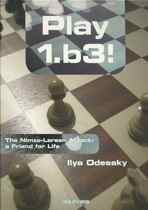Play 1.b3 — The Nimzo-Larsen Attack
A Friend For Life
Ilya Odesskey

Play 1.b3: The Nimzo-Larsen Attack by IM Ilya Odesskey is a very personal look at this flank opening which first attracted widespread attention when Bent Larsen used it so successfully in the early 1970s.
Odesskey, who is best known as a chess coach and writer in his native Russia, believes that his favorite 1.b3 is a viable and independent system that can be used for White against all levels of opposition. His book is a smorgasbord sometimes offering sharp analysis of critical positions (1.b3 e5 2.Bb2 Nc6 3.e3 d5 4.Bb5 Bd6 5.f4) using a traditional opening book format, and other times featuring model games to illustrate typical middle game plans.
Odesskey is always entertaining and good at creating a dialogue with the reader. This is certainly the case when he goes into an analysis of the position arising after 1.b3 e5 2.Bb2 d6, which a certain Grandmaster “Z says offers only one good move for White but without giving the answer! It certainly is not 3.e3 Nf6 4.d4 as 4 …exd4 5.exd4 d5 leaves White on the bad side of an Exchange French. Nor is 1.b3 e5 2.Bb2 d6 3.c4 c5 4.e3 Nc6 5.Nf3 g6 6.d4 exd4! 7.exd4 Bg7 what the first player is looking for. Odesskey initially comes to the conclusion that White does best to develop with d3, g3, Bg2, e3 and Nge2 along the lines of Larsen-Kavalek, Lugano 1970. That said the author is not satisfied with this as White is forced into a position that more closely resembles the English than those arising from 1.b3.
Finally Odesskey comes to the conclusion that Whites only good move is 3.e3. In most cases White will not follow up with d4 but if 3 …c5 4.d4! is strong. Problem solved? Not quite! Odesskey then looks at what happens if Black tries a slightly different approach 1.b3 c5 2.Bb2 d6. Now 3.e3 is met by 3 …Nc6 (4.Nf3 e5! 5.d4 cxd4 6.exd4 e4! 7.Nfd2 d5!) and 3.Nf3 allows 3… e5 so what can White do? Odesskey finally finds the idea 1.b3 c5 2.Bb2 d6 3.e3 Nc6 4.Ne2!? while travelling on the Moscow Metro with the idea 4… e5 5.d4 exd4 6.exd4 e4 7.d5! and there is no Knight to capture on f3.
One chapter entitled the Litus Gambit deals only with the sequence 1.b3 d5 2.Bb2 Bg4 3.f3 with the idea 3… Bh5 (not 3 …Bc8 as after 4.f4 White is playing the Bird with an extra move) 4.e4!? dxe4 5.Qe2 reaching the tabiya for this line. Another section of the book looks at the reversed line from the Petrosian System in the Queens Indian 1.b3 d5 2.Bb2 c5 3.e3 a6 and yet another playing ala the Trompowsky with 1.b3 Nf6 2.Bb2 g6 3.Bxf6.
While Odessky does his best to make 1.b3 a completely independent system, in some cases this is not possible. If Black adopts a London setup with …d5, … Nf6, …Bf5, …e6, …Be7, …h6 and 0-0 White pretty much has to choose between fianchettoing both Bishops and play for e4 ala the Kings Indian Attack or opting for a Reti setup with c4. Both lines are analyzed by the author.
Play 1.b3: The Nimzo-Larsen Attack is full of interesting and thought provoking comments and observations. For example, after 1.b3 d5 2.Bb2 Nf6 3.Nf3 Bf5 4.g3 e6 5.Bg2 Be7 6.d3 h6 7.Nbd2 0-0 8.0-0 Bh7 9.c4 c6 10.Qc2 Nbd7 11.a3 a5 12.Bc3 b5 13.cxb5 cxb5 a key position in the Reti is reached.
Botvinnik, in his famous three-volume trilogy of best games, writes that 14.b4 is a mistake that creates a weak pawn on b4 with no compensating factors. Two-time Soviet Champion Lev Psakis commenting on his game with Ubilava in Chess Informant 37 gives the move an exclamation mark! Who is right?
Botvinnik suggests 14.Bd4 is correct and gives White a slight advantage (14… b4 15.a4 or 14 Ne8 15.Bh3) but Odesskey is not buying. He believes that after 14… Qb8! Black has no problems. He then examines 14.b4 and comes to the conclusion that maybe the move does not deserve the exclamation mark that Psakhis gives it, but its the move that must be played. His final conclusion is that the Patriarch (aka Botvinnik) is right that White has no advantage, but Black is not better either.
Play 1.b3: The Nimzo-Larsen Attack is a stimulating and thought provoking book which I can highly recommend to those looking for a guide to 1.b3.
